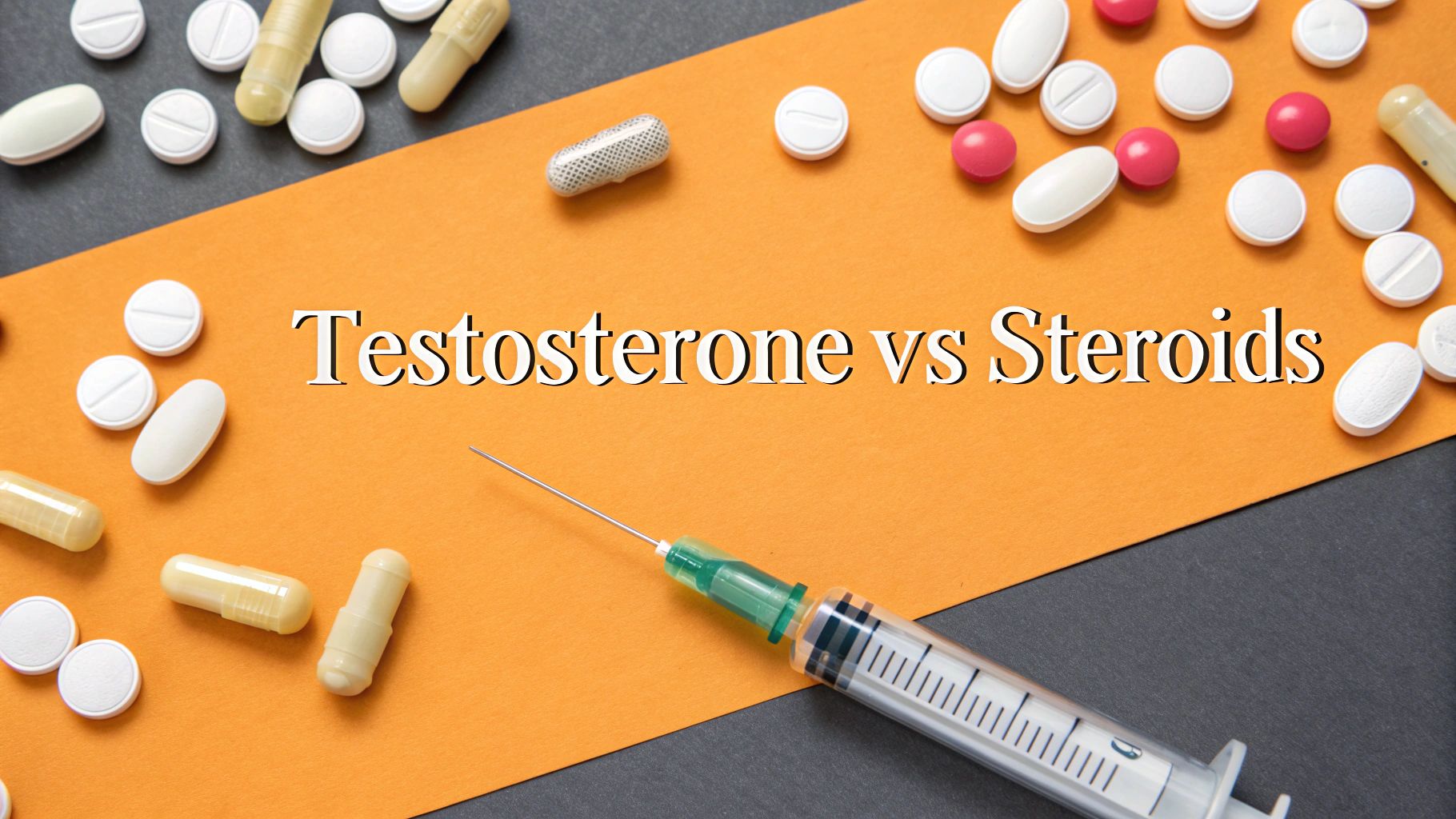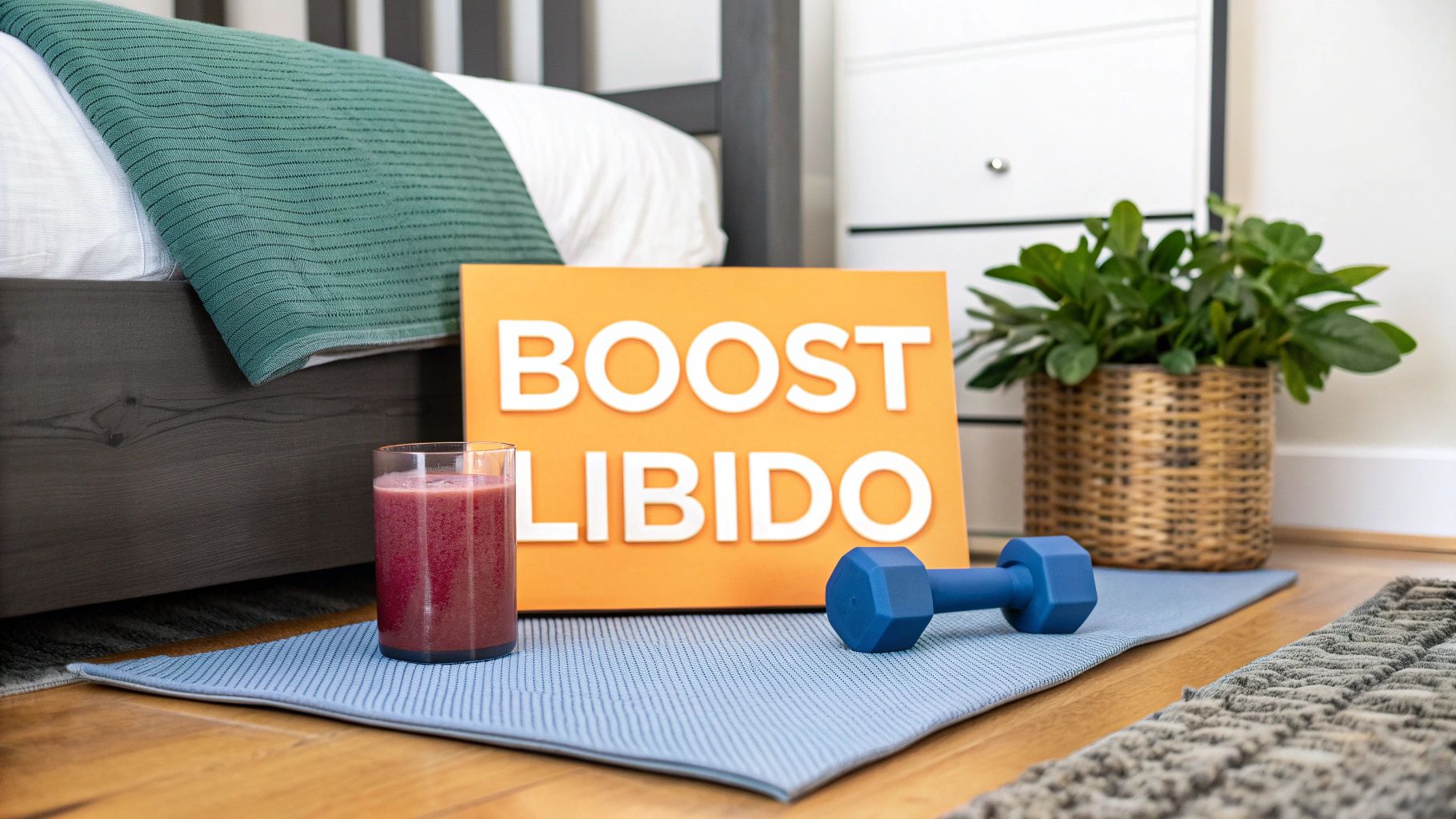Master Self Administering Testosterone Injections Safely
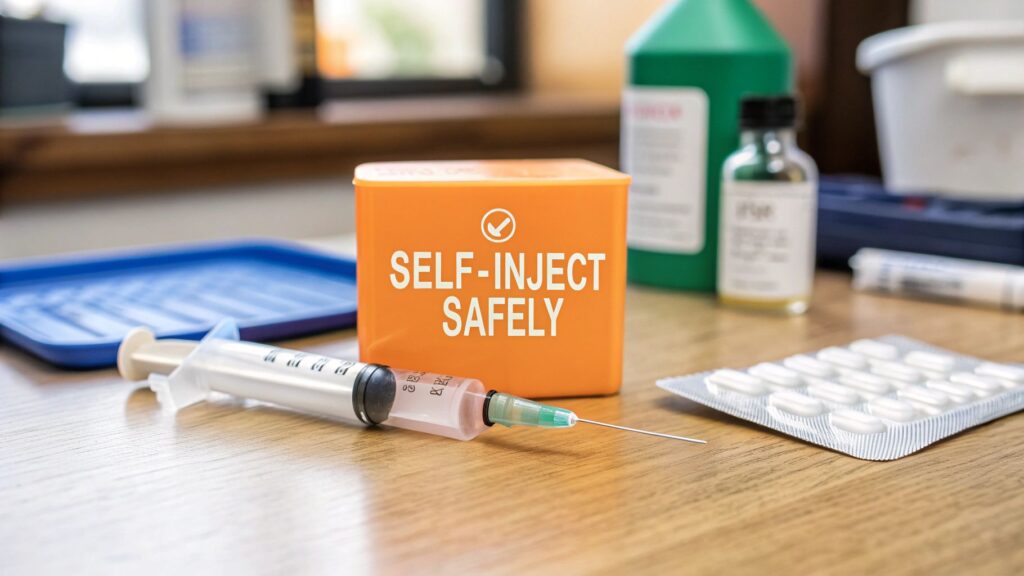
Taking the reins of your Testosterone Replacement Therapy (TRT) by self administering testosterone injections is a far more common and empowering choice than you might think. This shift toward at-home care isn't just a trend; it's about giving you greater flexibility, privacy, and most importantly, direct control over your own treatment schedule. It’s a practical move away from constant clinic visits and toward a sustainable, self-managed approach to your health.
Why More People Are Self-Injecting Testosterone
The thought of giving yourself a shot can be a little daunting at first. I get it. But there's a reason it has become the standard of care for so many on TRT. Once you get past that initial mental hurdle, you unlock a level of convenience and consistency that’s nearly impossible to match with rigid clinic appointments. You’re no longer a passenger—you’re in the driver's seat of your own therapy.
This isn't just a hunch; it's a well-documented shift in how TRT is managed. A 2014 patient survey found that almost 90% of respondents were already handling their own testosterone injections, which points to a huge preference for at-home treatment. The study even went so far as to recommend that clinics should proactively teach patients this skill to improve both access to care and overall satisfaction. You can read more about these patient-centered findings to see the clinical thinking behind this approach.
The Real-World Benefits of At-Home TRT
When you manage your own TRT schedule, the advantages become obvious almost immediately. It’s about so much more than just skipping traffic or avoiding a waiting room. It's about making your treatment fit seamlessly into your life, not the other way around.
Some of the biggest wins include:
- Unmatched Convenience: No more blocking out your workday for a nurse's appointment. You can administer your injection whenever it suits you—first thing in the morning, after a gym session, or on a quiet weekend—without throwing your entire schedule off track.
- Enhanced Consistency: Sticking to a precise schedule is everything when it comes to maintaining stable hormone levels and dodging those frustrating energy peaks and valleys. Self-injecting means you never have to miss a dose because the clinic is closed or you couldn't get an appointment, leading to much better symptom control.
- Potential Cost Savings: While you'll have the initial cost of supplies, you completely eliminate co-pays for frequent nurse visits and all the associated costs of travel. Over the long run, these savings can really add up, making long-term therapy much more affordable.
By learning to self-administer, you aren't just performing a medical task; you are reclaiming autonomy over your own health. This sense of control is one of the most powerful—and often overlooked—benefits of at-home TRT.
Building Confidence and Overcoming Hesitation
Feeling a bit apprehensive about the process is completely normal. The key to moving past that feeling is getting the right education and preparation from the start. Your healthcare provider will walk you through the entire technique, making sure you understand every step, from sterile prep to the injection itself. Armed with the right knowledge, self-administering testosterone becomes just another simple, routine part of your health regimen.
While injections are a cornerstone of TRT, getting the full picture of your hormonal health is also important. For anyone interested in a deeper dive, our guide on the secrets to boosting testosterone levels with science-based methods offers some great complementary information. Ultimately, mastering this one skill is a direct investment in your long-term well-being.
Choosing Your Injection Method and Site
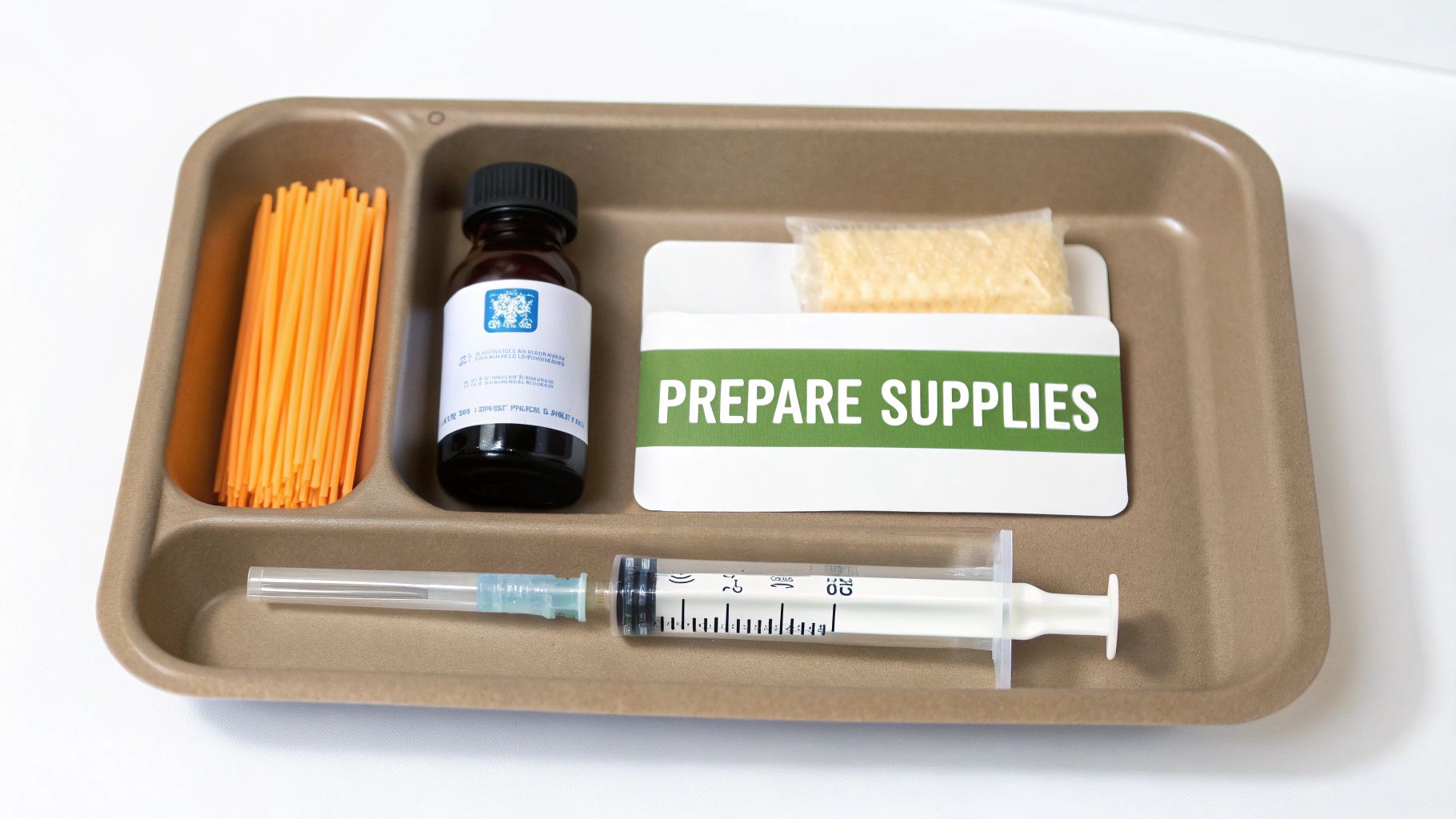
Alright, before you dive into your first self-injection, you and your doctor need to decide on the best game plan for your body and your lifestyle. There are two primary ways to do this: intramuscular (IM) and subcutaneous (SubQ) injections. Both get the testosterone where it needs to go, but they feel different and involve different techniques.
Think of it like watering a plant. An IM injection is like giving the soil a deep soak to get right to the roots, delivering the testosterone directly into the muscle. A SubQ shot is more like a slow-drip irrigation system, placing the hormone into the fatty tissue just under the skin for a more gradual absorption.
Which one you pick will shape your whole TRT experience, from needle size to how often you inject. Getting familiar with these differences is the first real step toward building a routine you can actually stick with.
Comparing Intramuscular vs Subcutaneous Injections
When you’re weighing IM versus SubQ, it’s not just about where the needle goes—it's about the entire experience. These two methods have key differences in everything from the equipment you’ll use to how your body absorbs the testosterone. For many guys, the choice comes down to personal comfort and what feels most manageable for a long-term routine.
This table breaks down the main distinctions to help you see which approach might be a better fit for you.
| Feature | Intramuscular (IM) | Subcutaneous (SubQ) |
|---|---|---|
| Injection Depth | Deep into the muscle tissue. | Into the fatty layer just beneath the skin. |
| Needle Size | Longer and thicker (1" to 1.5"). | Shorter and thinner (around 0.5"), like an insulin needle. |
| Absorption Rate | Faster absorption from muscle tissue. | Slower, more gradual absorption from fat tissue. |
| Pain/Comfort | Can be more painful; potential for muscle soreness. | Generally less painful and less intimidating for many. |
| Ease of Use | Can be more difficult to self-administer depending on the site. | Easier to self-administer, with more accessible sites. |
Ultimately, there's no single "best" method—it’s about what works for you. While IM has been the traditional go-to for years, many now prefer SubQ for its simplicity and comfort, which often makes it easier to stay consistent with your TRT plan.
Identifying Safe Injection Sites
Once you’ve settled on a method, you need to pick your spot. This is a critical step. You absolutely must rotate your injection sites to avoid building up scar tissue, which can make future injections painful and less effective. Think of it like a baseball field—you don't want to wear out one patch of grass by playing on it every single day.
Here are the most common and safest sites for each method.
For Intramuscular (IM) Injections
- Ventrogluteal (Hip): This is often called the gold standard for IM injections. It’s a large, stable muscle located far away from major nerves and blood vessels, making it one of the safest spots you can choose.
- Deltoid (Shoulder): A very convenient and easy-to-reach spot. However, it's a smaller muscle, so it’s best reserved for lower-volume injections to avoid too much soreness.
- Vastus Lateralis (Thigh): The outer middle third of your thigh is another solid choice that’s easy to access yourself.
For Subcutaneous (SubQ) Injections
- Abdomen: The fatty tissue around your navel is a popular and easy-to-reach target. Just be sure to stay at least two inches away from the belly button itself.
- Outer Thigh: The fatty part on the upper, outer area of your thigh provides another simple and effective site.
- Upper Buttocks/Hip: The fatty area on the upper portion of your glutes is also a great, comfortable spot for SubQ shots.
Your doctor is your best resource here. They can help you create a rotation map and physically show you the right anatomical landmarks for each site to ensure every injection is safe. For anyone still weighing different TRT methods, our guide comparing testosterone oral vs injection therapies offers a broader look at the pros and cons of various delivery systems.
Your Injection Preparation Checklist

From my experience, I can tell you that a smooth, low-stress injection is 90% preparation and only 10% action. The few minutes you spend getting your station set up beforehand are what truly build confidence and ensure a safe process. Think of it as your own personal pre-flight check. When everything is organized and ready, you can be calm and focused when it’s time for the actual injection.
Your goal is to create a clean, organized, and dedicated space. This isn't something to rush through on a cluttered bathroom counter. Find a flat, stable surface where you can lay out all your supplies without worrying about them rolling away or getting contaminated.
Assembling Your Supplies
Before you touch anything, wash your hands thoroughly with soap and water. Then, gather everything you need and lay it out in one spot. Trust me, having to stop mid-process to hunt for an alcohol pad is a surefire way to get frustrated and risk contamination.
Here’s your essential supply list:
- Testosterone Vial: The medication itself. Give it a quick once-over to check the expiration date and make sure the liquid inside is clear, with no specks or cloudiness.
- Correct Syringe and Needles: Your doctor will prescribe specific needles, likely a larger one for drawing the testosterone and a smaller one for the injection. Keep them in their sterile packaging until you’re ready.
- Alcohol Prep Pads: Grab at least two. You'll need one for the vial top and another for your skin.
- Sterile Gauze or Cotton Ball: For applying light pressure after the injection is done.
- An Approved Sharps Container: This is non-negotiable. Safe disposal is just as important as the injection itself.
The most overlooked step is often the simplest: take a deep breath. A calm mind leads to a steady hand. Rushing the setup is where mistakes happen, so give yourself a few quiet moments to get centered before you begin.
Preparing the Dose
Once your station is set, it's time to get the testosterone ready. This part is crucial for maintaining sterility and drawing up an accurate dose.
First, take a fresh alcohol pad and give the rubber stopper on top of the testosterone vial a vigorous wipe. Let it air dry for a few seconds—don't blow on it or wipe it.
Next, you'll want to equalize the pressure inside the vial. Testosterone is oil-based, and this trick makes it much easier to draw. Pull back the plunger on your syringe to fill it with an amount of air equal to your prescribed dose. With the vial sitting on your flat surface, push the needle through the center of the rubber stopper and inject the air into the vial.
Now, with the needle still in the vial, carefully flip it upside down. Pull back the plunger to draw your exact dose of testosterone into the syringe. Don't stress if you see a tiny air bubble or two. You can gently flick the side of the syringe with your finger to make them rise to the top, then push the plunger just enough to expel them.
This entire preparation phase of self administering testosterone injections is what sets you up for a smooth and sterile procedure every single time.
How to Perform the Injection Safely
Alright, you've got your supplies laid out and your dose drawn up. This is the moment that can feel a little intimidating at first, but trust me, with the right technique, it quickly becomes just another routine task. The secret isn't about being fast—it's about being smooth, steady, and remembering the specific angle your doctor showed you for your type of injection.
The first thing to get right is your grip on the syringe. Don't clutch it like it's some scary medical device. Instead, hold it more like a pencil or a dart. This light but firm grip gives you far better control and dexterity, which is the key to making the whole process more comfortable.
This infographic breaks down the entire weekly cycle, from the shot itself to proper tracking, helping to lock in the routine.
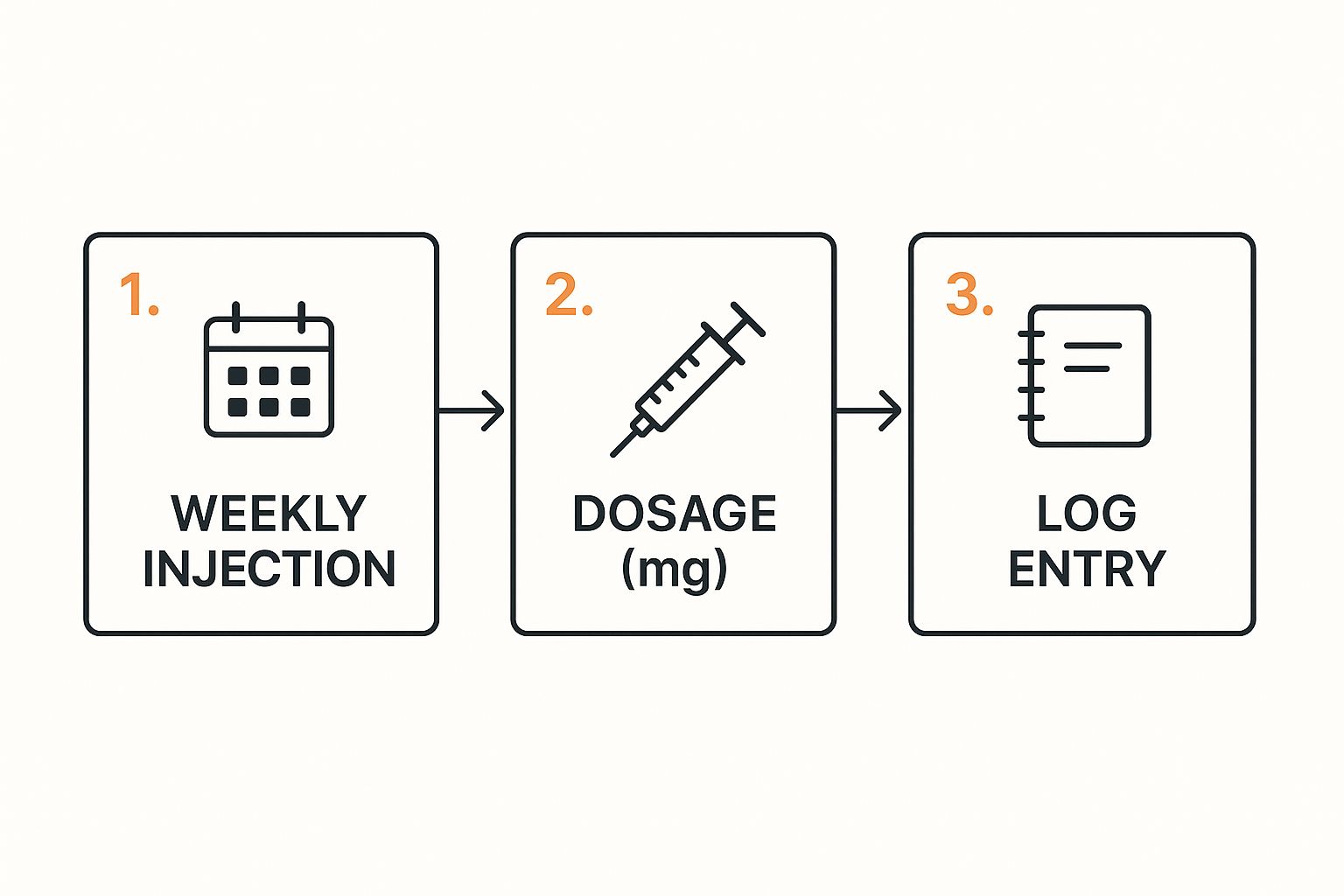
As you can see, a successful injection is just one piece of a consistent process that includes precise dosing and careful logging.
The Moment of Injection
Take a final, deep breath and completely relax the muscle you’re about to use. It’s natural to tense up, but fighting that urge makes a huge difference, especially for intramuscular shots. If you're injecting into your thigh, for instance, sit down and let your leg go totally limp on a chair or bed.
Grab a fresh alcohol pad and give the injection site one last clean. Let it air dry completely—don’t blow on it or wave your hand over it. While it’s drying, use your other hand to manage the skin. For an intramuscular shot, you'll want to hold the skin taut. If you’re doing a subcutaneous (SubQ) shot, you’ll gently pinch about an inch of skin and fat instead.
Now, it’s time to line up the syringe at the right angle.
- For Intramuscular (IM): The needle goes in at a straight 90-degree angle. Think of it as going directly down into the muscle.
- For Subcutaneous (SubQ): You’ll use a 45 to 90-degree angle, depending on the injection site and how much fatty tissue is there.
When you're ready, use a quick, firm, and confident motion to insert the needle. Hesitating is what often makes it more uncomfortable. Once the needle is all the way in, you can use your non-dominant hand to stabilize the syringe.
Administering the Testosterone
With the needle securely in place, slowly and steadily push the plunger all the way down. A controlled, even pace is especially important with oil-based solutions like testosterone because it helps prevent post-injection soreness. Pushing the fluid in too fast can cause unnecessary discomfort later.
Once the syringe is empty, pause for just a second or two before pulling the needle out. This little trick gives the oil a moment to start settling into the tissue. Then, withdraw the needle at the exact same angle it went in, using a single smooth motion.
Immediately engage the needle's safety mechanism if it has one, or place it directly into your sharps container. Whatever you do, never try to re-cap a used needle. That's how accidents happen.
Pro-Tip: Fight the urge to rub the injection site afterward. Instead, just apply gentle pressure with a sterile cotton ball or gauze pad for about 30 seconds. Massaging the area can actually cause the oil to leak back out and might lead to bruising or irritation.
It’s perfectly normal to see a tiny drop of blood or even a little bit of oil at the site. This doesn't mean you messed up or lost a significant part of your dose. It happens to everyone now and then. Gentle pressure is all you need. Mastering this physical process is what builds confidence and turns TRT into a manageable part of your life.
Post-Injection Care and Safe Disposal

Alright, you've completed the injection. But your job isn't quite finished yet. What you do in the moments and days after you self administer testosterone injections is just as important as the injection itself.
Proper aftercare and safe disposal are the final, critical steps in a responsible TRT routine. Getting this part right helps prevent irritation, ensures your body absorbs the medication properly, and keeps everyone in your household safe.
The second the needle is out, grab a sterile gauze pad or cotton ball and apply gentle pressure to the spot. Hold it there for about 30 seconds. The single most important rule here is do not rub or massage the area. This can cause some nasty bruising or, worse, push the testosterone right back out of the injection site before it has a chance to settle.
It’s totally normal to see a small drop of blood or even a tiny bead of the oil solution. Don’t panic—it’s not a sign you did it wrong or lost a meaningful amount of your dose. Just keep that gentle pressure on, and it will stop in a few moments.
Managing the Injection Site and Monitoring
Especially when you’re new to this, a little bit of bruising, redness, or tenderness at the injection site is par for the course. These minor annoyances are usually temporary and should clear up within a day or two. The best way to avoid bigger problems, like scar tissue, is to be religious about rotating your injection sites.
Keeping a simple log of your injection dates and where you injected can be a game-changer. It’s an easy way to make sure you’re giving each spot plenty of time to fully heal before you use it again.
Careful observation is key to a successful TRT journey. Paying attention to how your body responds not only helps with injection technique but is also fundamental to your overall treatment. Understanding this is vital, which is why we recommend learning more about why monitoring is so important in testosterone replacement therapy to get the full picture.
The Responsibility of Safe Disposal
Let’s be crystal clear: properly disposing of used needles and syringes is a non-negotiable part of at-home injections. Tossing them into your regular kitchen trash is never okay. This creates a serious safety hazard for sanitation workers, family members, and anyone who might come into contact with your trash.
Here’s exactly what you need to do:
- Use a Designated Sharps Container: The moment you’re done, the entire syringe and needle assembly goes straight into an FDA-cleared sharps container. These are built from puncture-proof plastic and have a secure lid designed to keep everything safely inside.
- Find Safe Alternatives: If you don't have a sharps container on hand, a heavy-duty plastic jug—like one from laundry detergent or bleach—with a screw-on cap is a safe temporary fix. Just make sure it's clearly labeled.
- Locate Disposal Sites: Once your container is about three-quarters full, it's time to seal it up and get rid of it. Check with your local pharmacy, hospital, or public health department. Many offer drop-off programs, or your local waste management service can point you to an official disposal site.
Got Questions About Self-Injecting Testosterone? We’ve Got Answers.
Even after you’ve nailed down the basics, it’s completely normal for a few questions to pop up when you're holding the syringe yourself. Little uncertainties can feel like big deals in the moment, but don't worry—you’re not the first person to wonder about them. This is where we tackle those common "what if" scenarios head-on.
We've gathered the most frequent questions we hear from guys starting their TRT journey. The goal here is to give you practical, no-nonsense answers that help you move forward with confidence.
What If My Injection Is Painful?
Let's be clear: a quick pinch is one thing, but sharp or lingering pain shouldn't be your weekly routine. If your injections are consistently uncomfortable, there are a few usual suspects to investigate.
First, check your muscle. Are you tensing up right before the needle goes in? It's a natural reaction, but a tightened muscle is much harder to inject into and will almost always hurt more. Take a deep breath and consciously relax the entire area.
Next, think about your technique. A quick, dart-like motion is the way to go. Slowly pushing the needle in gives your nerves more time to register the sensation, making it feel more painful. Also, make sure the alcohol on your skin has completely air-dried. Injecting through wet alcohol is a recipe for a stinging sensation.
The single best way to keep injections comfortable long-term is to rotate your sites religiously. Sticking to the same spot over and over leads to scar tissue, which makes every future injection tougher and more painful. A simple log on your phone or a calendar is all it takes to make sure each site gets weeks of rest.
What Should I Do If I Miss a Dose?
First off, don't panic. Missing one testosterone dose isn't a catastrophe, especially if you realize it fairly quickly. What you should do next really depends on when you remember.
If it's only been a day or so since your scheduled shot, you can generally take your dose as soon as you remember. Then, just get back on your regular schedule for the next one. However, if several days have passed and you're already getting close to your next scheduled injection, the best move is often to just skip the missed dose and wait. Doubling up is not the answer. When in doubt, a quick call or message to your doctor is always the smartest move.
Is an Air Bubble in the Syringe Dangerous?
This is probably the number one worry for anyone new to self-injecting, but for intramuscular (IM) or subcutaneous (SubQ) shots, it's largely a myth. Seeing a tiny air bubble or two in the syringe is not a cause for alarm.
Of course, you should always try to get rid of large, obvious bubbles by flicking the syringe and gently pushing the plunger. But those tiny, "champagne" bubbles that cling to the side? They are completely harmless. An air embolism—the dangerous event people worry about—would require a significant amount of air injected directly into a vein, which is extremely unlikely to happen with proper IM or SubQ technique.
Looking ahead, research is even exploring ways to make injections more comfortable. For instance, clinical trials on needle-free subcutaneous testosterone delivery have shown it can maintain effective hormone levels with almost no pain. In one study, all 20 men reported significant symptom improvement with minimal discomfort, signaling a potential future alternative. You can read more about these needle-free findings and what they might mean for TRT.
Ready to take control of your health with expert guidance and premium therapies? At Elite Bioscience, we provide seamless access to high-quality TRT, peptide, and vitamin treatments delivered directly to your door. Start your journey with us today.
QUICK SEARCH
Make an account today to start your journey towards a better and healthier lifestyle.




